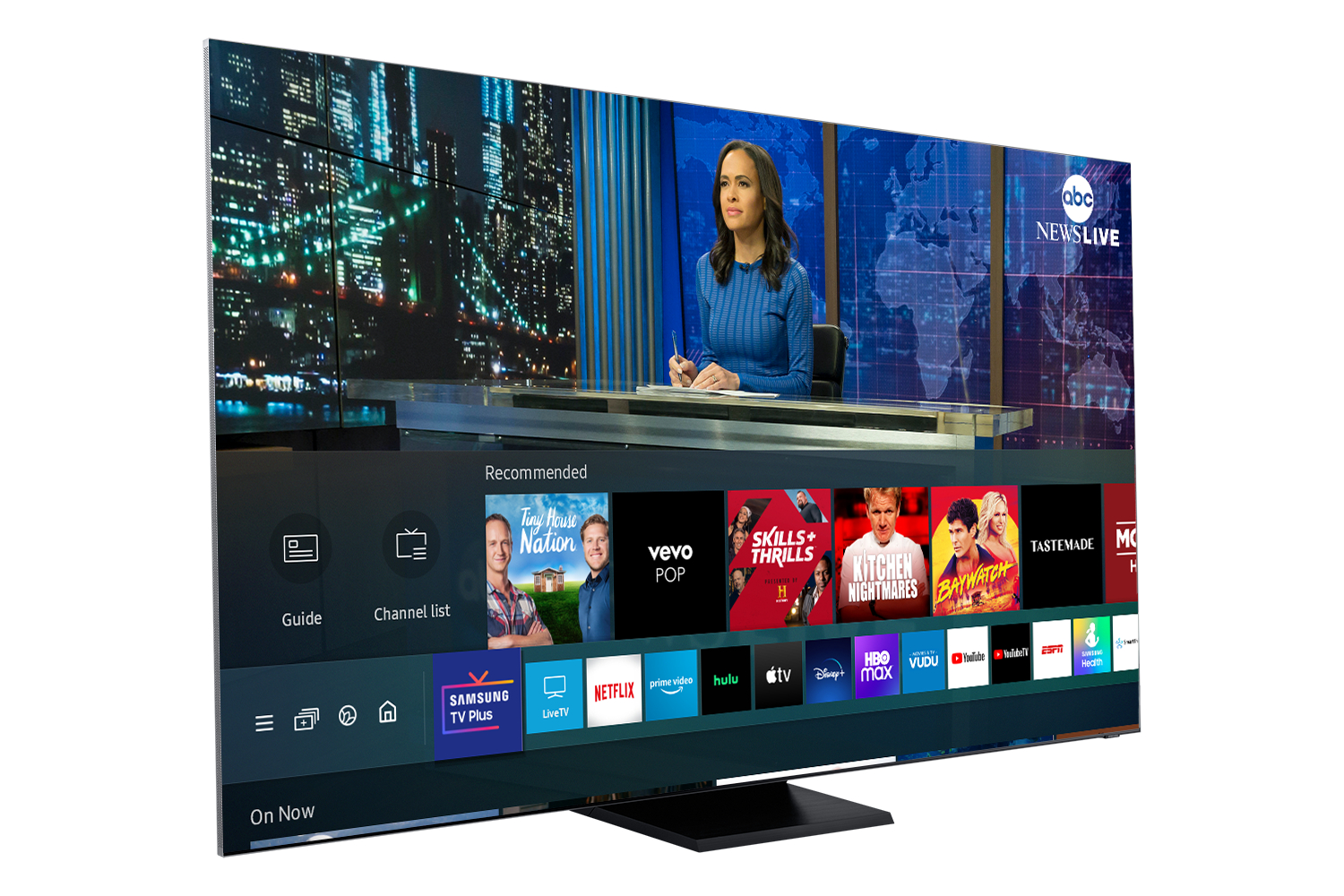Samsung TV Plus: Everything You Need To Know About Samsung’s Fast-Growing Streaming Service

Consumer-electronics giant Samsung first rolled out the Samsung TV Plus streaming app of video channels in 2015, at a time when Tubi and Pluto TV were independent startups just beginning to explore a nascent and unproven market for free, ad-supported streaming TV (FAST) services that emulate the traditional TV experience.
Originally conceived as a video rental platform, the service quickly pivoted to the free ad-supported model seen today, currently delivering more than 200 video channels. Samsung has been including the app on its Tizen-based smart TVs since 2016.
In September 2020 the service rolled out on select Samsung Galaxy mobile devices and tablets in the U.S. In April 2021, the company brought the service to mobile devices and tablets in Europe.
In June 2021, the company took another big leap forward with the introduction of a web version of Samsung TV Plus, opening it up to a wider audience and moving into direct competition with the likes of Tubi, Pluto TV, The Roku Channel and now Redbox Live TV in the burgeoning FAST space.
The web version is currently only available in the U.S. and South Korea. Like the TV and mobile apps, it’s free of charge to users. Users don’t even have to sign up for an account, although doing so unlocks personalization features like favorites lists, “continue watching,” watchlists and reminders.
Users can move seamlessly across devices from TV to mobile to the web to enjoy their content without missing a beat.
Also: Channel-Flipping Makes a Comeback
NEXT TV NEWSLETTER
The smarter way to stay on top of the streaming and OTT industry. Sign up below.
Recent Samsung TV Plus Updates
Michael Cardullo, principal product manager for Samsung TV Plus, gave an update on the service at the company’s recent developers’ conference. He reported that the service is installed on nearly 200 million devices worldwide.
“People are watching TV more than ever before and this new golden age of TV is all about streaming,” he said. “In the U.S., 63% of viewing on Samsung smart TVs is now streaming and a significant percentage of that viewing is happening on Samsung TV Plus.”
“Samsung TV Plus is one of the top-performing apps on our smart TV platform across all categories and has doubled the number of monthly active users over the last year,” Cardullo added. “We've increased our channel lineup to over 1,200 channels across 23 countries.”
In the United States the channels number over 200. Recent additions include Electric Distribution’s ElectricNow, featuring action/adventure, sci-fi and fantasy fare including former TNT series Leverage and The Librarians; as well as the Samsung-owned channels The Hotel Inspector and Plated, a cooking channel featuring Gordon Ramsay and other top chefs. They joined the Samsung TV Plus lineup in June.
In May, Samsung used its upfront to announce a quartet of new topic-based, ad-supported channels focused on cooking, autos, home and holidays. Studio Gunpowder & Sky launched a channel based on its horror-themed Alter service on Samsung TV Plus in April.
T2, a youth-oriented spinoff of Sinclair Broadcast Group’s Tennis Channel, became Samsung TV Plus’s first live sports offering in March. Also that month, it added Antiques Roadshow U.K., an always-on stream from the BBC featuring episodes from the British iteration of Antiques Roadshow, hosted by Fiona Bruce. Sinclair’s streaming news service NewsON, which provides coverage from nearly 200 broadcasters in more than 100 U.S. markets, joined the Samsung smart-TV lineup in January.
As with other FAST offerings, the channel lineup features plenty of niche fare like The Design Network, The Dove Channel, Stories by AMC Plus and Drama Life along with channels devoted to a single show, like The Baywatch Channel, The Walking Dead Universe and a Hell’s Kitchen channel.
“The big news is news itself,” according to Cardullo. “Samsung TV Plus now has the most extensive premium news offering of any free, ad-supported TV service.” Live news streams are available from the major national broadcasters ABC, NBC and Fox, as well as local news, along with Newsy, Bloomberg QuickTake, Altice USA’s Cheddar and USA Today.
While the big networks still keep a stranglehold on big sporting events like the Super Bowl, college basketball’s March Madness and the NHL Stanley Cup playoffs, Samsung TV Plus offers a lineup of sports channels that includes beIN Sports Xtra, Fubo Sports Network, Pac-12 Insider and the ACC Digital Network.
Samsung TV Plus also supports 4K channels like Clarity 4K and Love Nature 4K.
Categories of channels include news & opinion, entertainment, crime, game shows, sports, food, home and travel, reality, Latino, international, comedy, gaming, kids, science and nature, sci-fi and horror, movies and music — covering just about every genre.
Samsung TV Plus Integrated in Samsung TVs
The service is tightly integrated into the program guide on Samsung’s smart TVs displaying TV Plus content alongside broadcast programming, allowing users to jump right in and start watching.
The mobile app also supports screen-mirroring and Chromecast so viewers can cast from their phone to the TV, which opens it up to users who have a Samsung phone, but not a Samsung TV.
Samsung unveiled a new version of its Tizen OS at January’s CES in Las Vegas despite being urged by some gadget mavens to ditch the proprietary system in favor of the Google-owned Android TV, which would bring the sets in line with Samsung’s Android-powered smartphones. The update included a new “Media Screen” that Samsung said is meant to “put all of your streaming content into one easy-to-browse place.”
Samsung also said it would embed its Samsung Gaming Hub, a cloud gaming app, into its line of smart TVs, switching on support for the product in some 27 countries starting June 30. Samsung TV users will gain access to more than 100 games from the Xbox Game Pass Ultimate library, but they’ll need a subscription to play.
Terry Ho, who heads media operations and curation for Samsung TV Plus, explained that the company works with a variety of video distribution platforms to on-board linear channels and on-demand content, giving content owners the flexibility to select a vendor that suits their needs.
The company also works with individual channel partners to help mimic the traditional TV experience. “Once this process begins, we work closely with content owners on stream configuration, ad tag implementation, metadata mapping, and even channel logo formatting to ensure high-quality standards are maintained throughout our channel offerings,” Ho said.
The company helps convert originating feeds to formats that stream best across TV, mobile and the web, relying on HVEC (H.265) compression to save on CDN bandwidth costs. Samsung’s quality assurance processes cover video encoding quality, caption sync, program metadata and ad insertion.
“As we continue to grow, we also continue to optimize components of our FAST ecosystem to work seamlessly with the Samsung device platform, providing a single source of content input that delivers to multiple devices and territories to ensure a full pipeline of rich content offering to our viewers,” Ho said.
According to Samsung TV Plus engineer Jinju Lim, recent behind-the-scenes updates have made the platform more scalable and flexible, enabling the company to take a modular approach to updating without having to update the entire platform.
“Now we are also able to reorganize various channels and content more accurately and more quickly than ever,” she said. “We also built an extensive data analytics pipeline for TV Plus, so we can provide content with better quality of experience for our users.”
Advertising on Samsung TV Plus
Andrew Dickerson, Samsung TV Plus principal engineer, explained that in addition to working with all the major ad-insertion platforms, Samsung has its own global server-side ad insertion platform that helps partners monetize their content and offers the ability to split ad inventory. Samsung TV Plus offers a full suite of services, including ad routing, CDN, content hosting, channel playout and analytics.
Dickerson said that the platform has delivered billions of ads across hundreds of channels.
“One of our most recent tech launches is local channels where our servers leverage the viewer’s region and designated market areas to determine the appropriate local weather and local news feeds to show,” he said.
And of course, the same technology can be used for highly targeted advertising.
For an electronics behemoth with $63 billion in Q3 revenue in 2021, a free streaming service might tend to get lost in the financial reports, but ads and services revenues are projected to grow dramatically over the next five years.
According to a recent report from TV[R]EV, ad revenue for the three biggest U.S. smart TV OEMs — Samsung, LG and Vizio — is expected to see 4.5 times growth over the next five years, from $1.37 billion in 2021 to $6.17 billion in 2026.
And while subscription-based services like Netflix and Disney Plus face constant churn, as viewers binge on the latest hit and then churn away, free services are always there as soon as you turn on the TV, waiting to fill the void, while offering advertisers a highly targeted platform to get their message out. ■
Freelancer Scott Lehane has been covering the film and TV industry for almost 30 years from his base in southern Ontario, near Toronto. Along with several Future plc-owned publications, he has written extensively for Below the Line, CinemaEditor, Animation World, Film & Video and DTV Business in the U.S., as well as The IBC Daily, Showreel and British Cinematographer in the U.K. and Encore and Broadcast Engineering News in Australia, to name few. He currently edits Future’s Next TV, B+C and Multichannel News daily SmartBriefs. He spends his free time in the metaverse, waiting for everyone else to show up.

